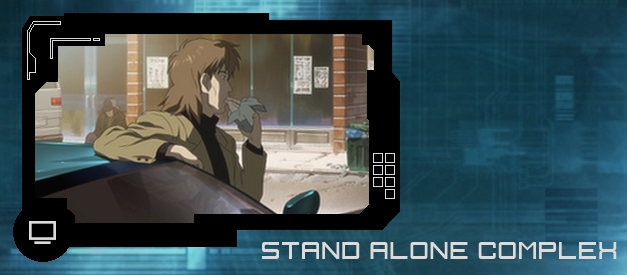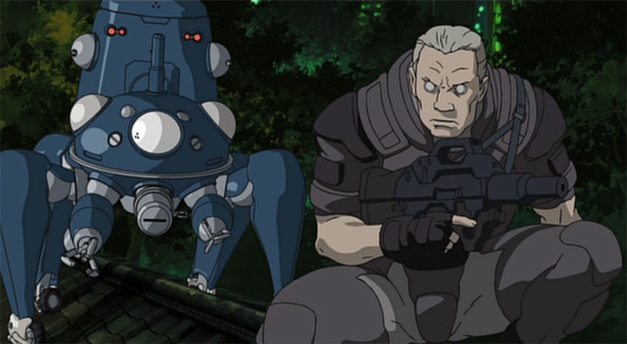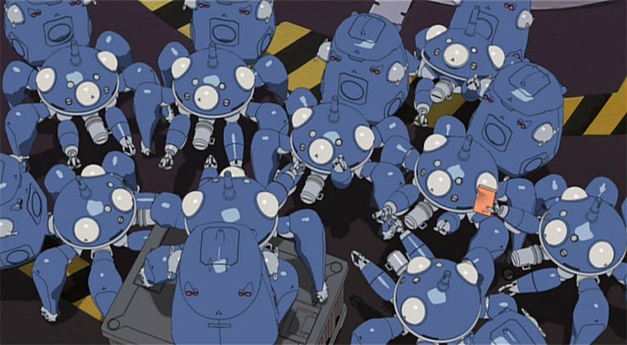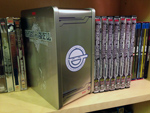
If you've been reading this feature up to now, then you already know that the Ghost in the Shell series primarily follows a special group in Japan's Public Security agency called Section 9. The group deals with criminal activities in a digital world where hackers are a common entity in the near future. So far we've followed the series in print with graphic novels, seen the film adaptation, and played a video game which provided an active experience for the adventures Section 9 goes through. While these mediums work well with the franchise as a way to present the materials with, the best fit for it would definitely have to be television, which is what they used for the next installment with Ghost in the Shell: Stand Alone Complex.
As usual, this franchise is a complicated one, always dealing with subjects that are difficult to follow for reasons dealing with complex criminal cases and a future where things like advancements in technology and the lingo may throw you off with your knowledge of how procedures work in the present era. So by giving the material 26, 30 minute episodes, it gives an opportunity for the content to breath with the allotted time, rather than condensing all of it into something like a 90 minute film.

In today's era of television, it's chock-full of procedural dramas with shows like NCIS, Criminal Minds, and Blue Bloods. They follow the formulaic pattern of looking into a criminal case from the prospective of law enforcement by gathering clues, piecing them together, and then having a climatic showdown where the team confronts the person behind the crime. Hey! That's the template Ghost in the Shell uses too, so it would fit perfectly into this category. The only major difference being is that Stand Alone Complex is completely animated as opposed to being live-action, having it stand out from the crowd and allowing it to be more creative than your average cop show due to it taking place in the future.
Setting itself apart from the books, the TV show takes place in an alternative timeline, an advantage for newcomers as they can come in without the need to watch or read any of the material that came before it. Taking place in the year 2030, Episode 1 introduces the viewer to the world by watching Section 9 resolve a hostage crisis while in their full tactical mode to start things off with a bang. Next, after the dust has settled, they piece together their clues to get to the bottom of what's really the cause of the incident. And then there's the climax, of course, where they try to take down the perp in question.
In addition, Episode 1 does a really great job with character introductions. At one point, team leader Motoko Kusanagi walks around HQ, briefly talking to each member in Section 9. You get their names and a taste personality from each of them. For a TV show, this is really helpful as it starts off with a cast of eight that work within S9, so we need to get names and faces down quickly. Episode 1 also sets the tone for the kind of activities the group will be meddling with: cyber-like crimes and political scandals.

In the documentary that interviews the many people who worked on SAC, there's an interesting discussion with Director Kenji Kamiyama where he noted during the brainstorming sessions at the beginning when the details of the show were getting hammered out, they were planning to have it follow the manga in terms of how information is fed to the viewer. In the manga, there's a ton of information describing how technology works in this world, so Shirow Masamune included many margin notes alongside the panels in his books, so there's a lot of information being dumped on the reader. Kamiyama said the writing team toyed with the idea by including this with the TV show by having text bubbles appear on screen when some kind of new tech is introduced. Thankfully they backed away from that and instead inserted the technical discussions within dialog. The end results are far better by having the technical jargon flow naturally into the conversations, explaining things well with sometimes the assistance of visual aids like having the person who's describing the tech sitting in front of a computer monitor looking at the technology in question on the screen.
For the 26 episodes, about half of them are stand-alone, self-contained stories where a case begins and ends in the same 30 minute show; allowing someone to jump in without fear of continuations. The first few episodes are like this, but then there is a more complex, arching story that takes up the other half of the episodes. Although, this case is peppered across the whole season, so that story is surrounded by the self-contained ones. You can tell which episodes are part of the arching story by the color of the episodes' title cards; which are blue. For this case, it involves something called the Laughing Man incident.

A strange name to call a case, but it's a complicated one full of layers and points in all sorts of directions, causing Section 9 to search deep into the net to discover who is actually behind all of these incidents. Although, time is not on their side initially as a public threat is placed on the Police Commissioner by the Laughing Man himself. What makes it tough to catch him is due to his skills as an elite class-A hacker, making his prints on the net hard to detect and difficult to deduce where he plans to appear next. Section 9's independent investigation on the case is thanks to Togusa's old colleague who he used to work with while being a detective for the police. He supplied Togusa with evidence to begin an investigation, and without him, the case may have been buried under falsified stories due to corrupt officials who don't want the public to know what they're really doing.
And in relation to this, even though the show focuses on S9 as a whole, Togusa seems to be the one who acts as the conduit between the viewing audience and the agency, in spite that he is not a leader like Kusanagi or in a higher position like Aramaki. For one, Togusa is the rookie of the group, having recently been transferred from his role as a police detective. This allows us to discover the inner working of Section 9 with fresh eyes. That, and add in the fact that he's one of the least of the group to have cyber implants, and to also be the only member of the group who appears to have a life outside of the organization by having a wife and kids. With these aspects of his life, you get the human connection with him, and I think that is what makes Stand Alone Complex one of the better installments for the franchise: the human element.
When compared to the 1995 film, Major Kusanagi is very robotic with her attitude towards everyone. She showed very little emotions which made it hard to connect with her. And same goes with the other major characters like Batou and Aramaki as they all seem to be intensely focused on the their jobs rather than their own lives. It just made them all seem rather soulless, which is ironic as the question of self-identity was a big topic for the film. For Kusanagi in this installment, she acts more down to earth and actually talks to her fellow group members. The banter between each member as they partner up in cases adds to the human element, making it more like a tight knit group than a bunch of robots giving long, cold stares at one another.
Considering the time when it aired, I think this was a show that invested heavily in using 3D computer models combined with traditional 2D drawings, showing how blending the two forms of animation can be done well when applying the 3D models to their strengths. For example, each scene is brought to life by adding a lot of traffic in the backgrounds where you see cars zooming by. All car models are 3D, allowing 2D animation to focus on character models and backgrounds while 3D were used more for filling in the world with machines and taking the demanding task of animating cars, especially when they turn, changing the angle in which you draw the car or having their size change as a car drives away or towards the camera.

Replacing the Fuchikoma model is a new type of personal tank called a Tachikoma. They are pretty much the same like what the Fuchikomas were, but look somewhat different. They still have the bubbly, childish personalities that act like the comedic characters for the group, so don't fret if you expect them to be different based on their exterior changes. All of the Tachikomas are computer generated models, allowing them to be more animated than if they were to be hand-drawn. Between the old and new designs, I think I prefer the newer look of the Tachikomas when compared to the original design of the Fuchikomas, but that's just my opinion.
Going back to that human element the show offers, there are episodes that will focus on a member in Section 9, delving into their past and giving the viewer a deeper understanding of how they got to working with S9 or what they did earlier in their careers. Batou has two great episodes that focus on his past. One deals with an incident he was involved in while enlisted in the Rangers during a mission in South America towards the end of a World War, while another has him confronting a person who he described as someone he looked up to due to him beating the odds and getting a silver medal during the 2020 Paralympics. Ultimately it would leave him distraught and emotionally frustrated seeing this person fall from grace for doing something he considers so idiotic.
Episode 2, "Runaway Evidence – TESTATION," would be a personal favorite of mine; being placed even above the complex case regarding the Laughing Man. With "TESTATION," we see the pursuit of a runaway military think tank with no communications with its pilot, so the reason for why it's operating or its destination is a mystery. The dialog between Aramaki and the executives at the company who developed the think tank are pretty good, having him apply pressure to the head honchos so they can cooperate with S9 and figure out how to stop their runaway weapon. Add in the ratcheting up of tension as the tank moves from rural farm fields to a metropolitan area where civilians are now at risk, and you got yourself a great episode. Again, that theme of the human element factors into this episode as well.

Section 9 feels more fleshed out here, actually doing more with background members of the group with Saito, Borma, and Paz than they have with previous installments of the franchise. They're involvement with missions are essential just like the primary members, occasionally getting paired up with big wigs like Kusanagi or Batou. This is important because S9 is a small group, so every person on the team has a significant reason why they were enlisted as members, so weight needs to be added to these characters to demonstrate how all rolls to a mission are crucial for it to succeed.
From a production standpoint, the English dub is excellent. SAC has a few voice actors reprising their roles while others are new to the cast. Back from the original crew are William Frederick as Aramaki and Richard Epcar as Bateau. Mimi Woods was replaced with Mary Elizabeth McGlynn as Motoko Kusanagi, Christopher Joyce with Crispin Freeman for Togusa, and Michael Sorich with Michael McCarty for scruffy-faced Ishikawa. All of these voice actors are well suited for their roles, giving their spoken dialogs a sense of importance; what with how significant their jobs are to public security.
So yeah, it's a pretty good show. If you wanted to jump into the Ghost in the Shell franchise, I'd say Stand Alone Complex is the best point of entry. If you're into procedural cop dramas, then don't let it being an animated series fool you. It's as good as any other of those shows, and possibly better since it's set in the near future with cool gadgets and weapons. Imagine if LL Cool J on NCIS: Los Angeles were semi-cyborg! Ladies Love Cyborg James!
 |
Ghost in the Shell: Stand Alone Complex
JP Original Broadcast: October 2002 DVD Volumes: 7 Episodes: 26 |
Posted on: February 16, 2017
